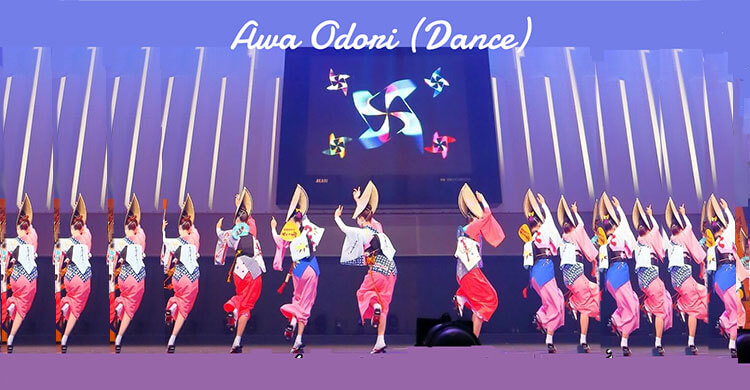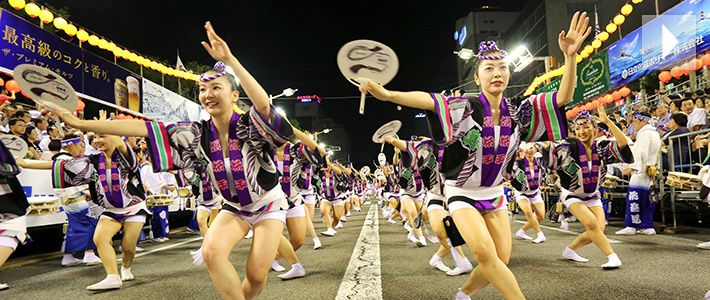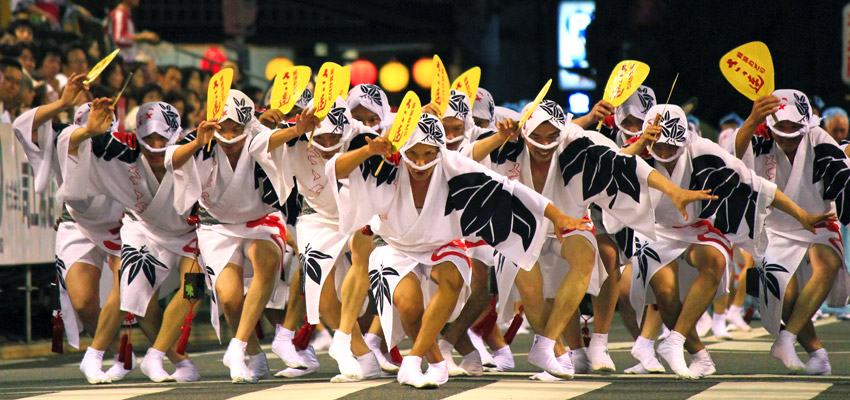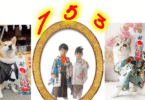Yattosa-Yattosa!
Yatto-Yatto!
The dancers are fools(Odoru ahou ni)
The watchers are fools(Miru ahou)
Both are fools alike so(Onaji ahou nara)
Why not dance?(Odorana son, son)
Hi Good evening, how are you? Tonight we enjoy “Awa Odori (Awa dance)”, which can be seen,first, watching the video.
Contents
The Largest Dance Awa Odori (dance) Festival
At first glance of unusual style of Odori, dancing and when we hear their chanting “fools” and the like during dancing, almost all spectators who’ve seen in the first time feel something odd, and they might have probably questions that ”is really this well-known the Japan’s biggest Odori, dance festival?”
What’s Awa Odori ?
Every year in August, the city of Tokushima, Tokuhshima Prefecture on the island of Shikoku becomes one big dance floor, as 10,000 people dance through the streets.
Called Awa Odori, this is one of Japan’s annual Obon events to honour the spirits of ancesotors.
The ritual which Awa Odori is based on is still practised in a fishing community in Tokushima.
Those who have lost a family member within the past year gather at the port.
This straw doll is said to act as a magnet for the souls of the departed.
People believe that facing the sea and calling out the names of the dead will bring their souls back to this world.
Then lively festival music is played. The participants form a circle and start dancing. This dance expresses the joy of having the ancestral spirits back for brief while.
It is a representative existence of Japan’s three major Bon Odori and Shikoku three major festivals, and it is one of Japanese traditional arts with about 400 years of history、attracting over 1.3 million tourists every year.
The Awa odori is the largest in the country in number of dancers and spectators
The Awa odori Dance Festival is held from 12 to 15 August as part of the Obon festival in Tokushima Prefecture on Shikoku in Japan.
Groups of choreographed dancers and musicians known as ren dance through the streets, typically accompanied by the shamisen lute, taiko drums, shinobue flute and the kane bell.
Performers wear traditional obon dance costumes, and chant and sing as they parade through the streets.
”Awa” is the old feudal administration name (about 1617-1871) for present Tokushima Prefecture.
The history of the Awa Odori
The earliest origins of the dance style are found in the Japanese Buddhist priestly dances of Nembutsu-odori and hiji-odori of the Kamakura period (1185–1333), and also in kumi-odori, a lively harvest dance that was known to last for several days.
Awa Odori’s independent existence as a huge, citywide dance party is popularly believed to have begun in 1586 when the daimyō of Awa Province hosted a drunken celebration of the opening of Tokushima Castle.
The locals, having consumed a great amount of sake, began to drunkenly weave and stumble back and forth.
Others picked up commonly available musical instruments and began to play a simple, rhythmic song, to which the revelers invented lyrics. The lyrics are given in the ‘Song’ section of this article.
This version of events is supported by the lyrics of the first verse of a local version of a popular folk song.
The term “Awa Odori” was not used until the 20th century, but Bon festivities in Tokushima have been famous for their size, exuberance and anarchy since the 16th century.
This suggests that by the 17th century, Awa’s bon-odori was a well established as a major event, lasting well over three days—long enough to be a major disruption to the normal functioning of the city.
It implies that samurai joined the festival alongside peasants and merchants, disgracing themselves with brawling and unseemly behaviour.
In 1674, it was “forbidden for dancers or spectators to carry swords (wooden or otherwise), daggers or poles”.
In 1685 revelers were prohibited from dancing after midnight and dancers were not allowed to wear any head or face coverings, suggesting that there were some serious public order concerns.
In the Meiji period (1868–1912) the festival died down as the Tokushima’s indigo trade, which had financed the festival, collapsed due to imports of cheaper chemical dyes.
The festival was revitalised at the start of the Shōwa period (1926) when Tokushima Prefectural authorities first coined the name “Awa Odori” and promoted it as the region’s leading tourist attraction.
What’s Obon?
The Awa Odori festival grew out of the tradition of the Bon Odori which is danced as part of the Bon “Festival of the Dead“, a Japanese Buddhist celebration where the spirits of deceased ancestors are said to visit their living relatives for a few days of the year.
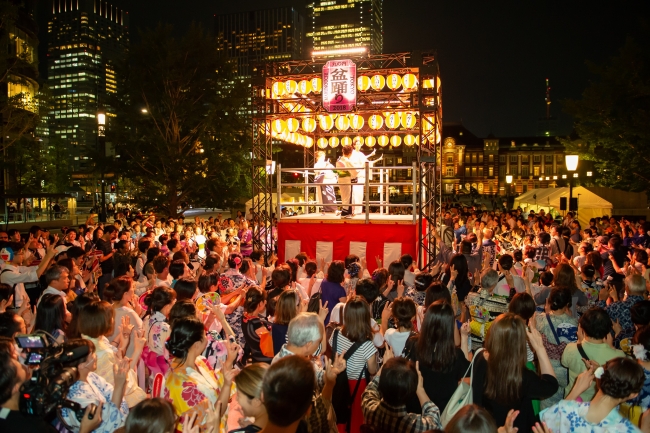
General people perform dansing around the “Bon Odori Stage”
This is the typical Obon festival which has been held almost everywhere in Japan in the middle of summer time.
Why not join and enjoy dancing so you could forget the wordliness completely?
Finally, while you would be in Japan, it could be well worth visiting Awa Odori! Have a lot of fun!
Finally, we have an article of “Obon” which is related to Awa Odori, please visit “Obon“, thanks

